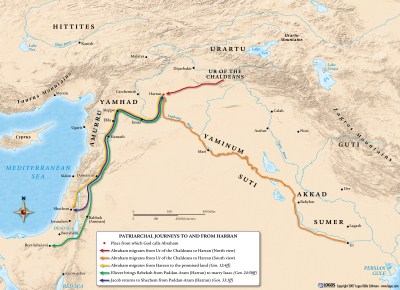Abraham’s Ur
Two cities known as “Ur” in ancient Mesopotamia make the specific identification of the site mentioned in Genesis 11:28–31 uncertain. “Ur of the Chaldeans” is typically identified as either a prominent metropolitan center in southern Mesopotamia or a trading center in northwestern Mesopotamia.
Akkadian tablets from the archives at Ugarit (ancient Syria) speak of merchants from the city of Ura, which was under Hittite control. The administrative records note that Ura was a city whose occupants specialized in foreign trade. These traders were not Bedouin nomads but international caravan traders—a description that fits the patriarchs (Gen 34:10; 42:34; a trader or socher).
At times these traders were permitted to acquire real estate in lands where they did business. In Genesis 23, Abraham purchases the cave of Machpelah from the Hittites at Hebron. Records from Ugarit confirm that the merchants of Ura had relations with Hittite cities and their authorities, which provides a context for Abraham as an itinerant merchant with international connections—something entirely consistent with his depiction as a wealthy businessman in the biblical accounts.
Situating Abraham’s Ur in the north also solves problems associated with a southern Babylonian location for “Ur of the Chaldees.” For example, Genesis 11:31 tells us that Terah moved from Ur of the Chaldees via Haran on the way to Canaan. This route makes little sense if Abram’s Ur is deep in southern Mesopotamia. Additionally, “Chaldees” has no necessary connection to Babylonia. The ancient Greek writer Xenophon describes the Chaldeans as a warlike people who impeded passage to Armenia—Hittite country (Xenophon, Anabasis 4.3.4). He also mentions Chaldeans in connection with the Carduchi (Kurds; Xenophon, Anabasis 5.5.17).
In Genesis 22:22, Chesed, the ancestor of the Chasdim (“Chaldeans”) is mentioned immediately after Aram (Syria)—in the northwest corner of the Fertile Crescent near Haran (Acts 7:2–5). Genesis 24:4–7 also describes the land of Abram’s birth as the country containing the city of Haran and the area known as Paddan-Aram.
Michael S. Heiser
Further Reading
 Ur CLBD
Ur CLBD
 Ur (city) ZEB Q—Z
Ur (city) ZEB Q—Z
 Ur DOT: P
Ur DOT: P

|
About Faithlife Study BibleFaithlife Study Bible (FSB) is your guide to the ancient world of the Old and New Testaments, with study notes and articles that draw from a wide range of academic research. FSB helps you learn how to think about interpretation methods and issues so that you can gain a deeper understanding of the text. |
| Copyright |
Copyright 2012 Logos Bible Software. |
| Support Info | fsb |
 Loading…
Loading…
